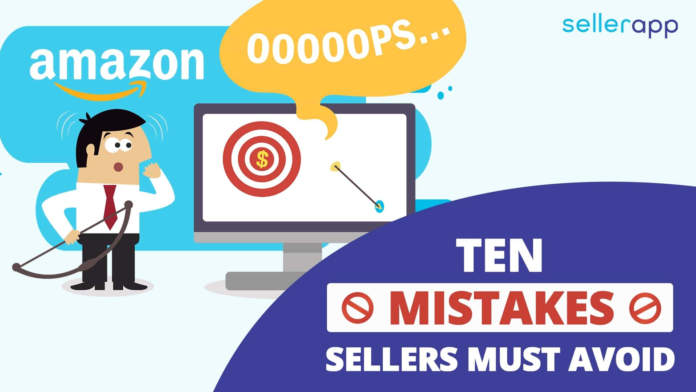Watch out for the following blunders that might affect the performance of your newly established Amazon store. Keep reading to see what they are!
For many aspiring entrepreneurs, Amazon is a wonderful platform to kick start their e-commerce store. Not only is it the most profitable online shopping website, but it is also beginner-friendly and easy to navigate.
However, enthusiasm can cloud judgments sometimes, leading Amazon retailers to make otherwise avoidable mistakes. If you want to ensure your business does not go through the same ordeals, keep reading the article and find out!
4 Typical Mistakes By Amazon Newbies When Setting Up Their Business
1. Choose unsuitable products
What you sell on your Amazon page is ultimately the key factor in deciding the success of your business. Therefore, it is worth taking time and effort to contemplate which products might end up being lucrative.
Sadly, many beginners take the wrong approach and feature items that are either too common or too niche. For highly sought-after products like personal electronic devices, casual clothes, or books, the competition level is up in the sky. There is no way a small, newly established store can attract customers and gain steady traffic compared to famous brand names.
Similarly, opting for peculiar, unorthodox items means you have fewer rivals to contend with. But it comes at the risk of having only a tiny target audience, and you may struggle to scale later on. In the long run, this prevents you from substantially increasing your revenue and expanding the customer base.
With that in mind, make sure you only set up your Amazon store after doing careful research into the inventory’s potential selling capability. Choose something in moderate demand, affordable for the majority of shoppers, and requires minimal effort in delivery.
2. Come up with marketing strategies unadvised

When you run a business, it is tempting to cover every single aspect on your own. However, certain areas – like marketing – call for extensive expertise and experience to execute the job flawlessly. Sure, you can give it a try if you want to organize an ad campaign on several platforms, track down the metrics, measure the performance of different tactics, and do a whole lot of other trivial tasks. But soon enough, you will realize that not only does it waste your time and effort, but marketing is also simply ineffective when done by an amateur.
Thus, a reasonable solution is to outsource an Amazon marketing agency within the first few weeks so that the hard work is well taken care of. Then, a team of professionals can offer you tailored advice on how to narrow down the target audience, which ad bidding process is suitable for your business goals, when and where to start hosting ad campaigns, etc. This way, you are more likely to reduce the cost involved by focusing your resources on what truly matters. And, of course, it means a higher ROI when everything is complete!
3. Fail to perform a listing audit
An Amazon audit allows retailers to optimize the store’s performance, improve the UI/UX and significantly boost conversion rate. Therefore, first-time owners must give a comprehensive audit before officially launching their landing page. Typically, there are three main factors you need to pay attention to, including photos, ad copy, and keywords.
- Photos: Online customers rely heavily on visual assistance when deciding whether to purchase an item. Do not forget to put in multiple images of your product, preferably taken from different angles, to illustrate how your product looks. Even better, you can put in a short video introducing the main features and recap the warranty policies of your business.
- Ad copy: Everything from the head title to the Description section can be classified as a copy. The more readable it is, the more persuasive it appears to customers. Briefly mention why your product stands out with info-packed bullet points and include any possible certifications that bear you out. Try to be short, concise, and professional with your writings.
- Keywords: Optimizing the keywords in a product listing is crucial since it directly enables the Amazon search engine to collect data and display the landing page whenever a relevant term is searched. Start by inserting keywords with high relevance and medium volume, and remember to put some variations in the backend. You can also utilize long-tail keywords to infiltrate specific sections of the market.
4. Underestimate the power of Amazon

Like most e-commerce platforms, Amazon imposes strict regulations upon its retailers to protect the rights of customers. If you violate the rules and make a mistake – however small it is, you run the risk of having the selling suspended. In the worst case, you might be losing what you have set up so far. And when such an incident happens, sometimes your complaints and justifications cannot reach out to Amazon at all. So how to avoid falling into this situation in the first place?
The answer is easy enough: carefully study the Policies & Agreements, as well as the Seller Code of Conduct. Everything related to Amazon’s policies on tax, performance guidelines, copyright, listing standards, and unethical selling practices are all available there. Make sure to note down essential bits and follow them closely to gear your store to safety.
Another vital reminder for you is that Amazon updates its limits and restrictions once every few months. Always be on the alert and look out for changes before they negatively affect you.
Conclusion
Setting up your Amazon store might sound like an effortless task. But the truth is, it requires knowledge and experience to meet the basic standards and evolve from there. If you are struggling to establish an adequate landing page, why not have a look at Olifant Digital? Here, rest assured that you will be provided with customized suggestions on improving the ins and outs of an Amazon business. Expect to see tangible results with your own eyes in no time!









